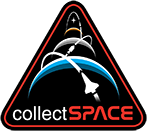|
Author
|
Topic: Remembering Elliot See and Charlie Bassett
|
Tom
Member Posts: 1768
From: New York
Registered: Nov 2000
|
 posted 02-28-2006 03:15 PM
posted 02-28-2006 03:15 PM
   
Godspeed to original Gemini 9 crew, Elliot See and Charlie Bassett, who left us 40 years ago today (Feb. 28, 1966).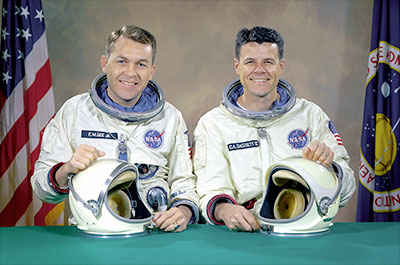 |
ColinBurgess
Member Posts: 2170
From: Sydney, Australia
Registered: Sep 2003
|
 posted 02-28-2006 04:21 PM
posted 02-28-2006 04:21 PM
   
Amen, Tom, Amen. God bless both these guys and their families. |
KC Stoever
Member Posts: 1023
From: Denver, CO USA
Registered: Oct 2002
|
 posted 02-28-2006 06:50 PM
posted 02-28-2006 06:50 PM
   
Candace Carpenter was called out of her Seabrook Elementary School classroom that day, 40 years ago. A bereft Sallie See needed her best friend. |
ASCAN1984
Member Posts: 1050
From: County Down, Nothern Ireland
Registered: Feb 2002
|
 posted 03-01-2006 06:29 AM
posted 03-01-2006 06:29 AM
   
Wow that long ago. There is a great description of the crash from both Tom Stafford and Gene Cernan in their books. Spaceflight magazine also had a great description. I think also "Fallen Astronauts" had one too. One little mistake can cost so much. Their names are on the spaceflight memorial mirror at Kennedy Space Center. |
Jim
Member Posts: 73
From: San Antonio TX
Registered: Mar 2006
|
 posted 03-17-2006 11:57 AM
posted 03-17-2006 11:57 AM
   
There is an elderly gentleman here in the Dallas area named Edgar See who says he is a distant cousin (second or third, I believe) to Elliot See.Ed See was an aeronautical engineer for Chance-Vought aircraft at Love Field for many years as well as owning a model/hobby shop here since 1948. |
John K. Rochester
Member Posts: 1292
From: Rochester, NY, USA
Registered: Mar 2002
|
 posted 10-28-2007 07:53 PM
posted 10-28-2007 07:53 PM
   
While at Kennedy Space Center for the STS-120 launch my wife and I visited the Visitor Center. While viewing the Astronaut Memorial mirror I happened to hear a tour guide from "Sun Tours" tell his group that "Bassett and See were killed while buzzing the hangar where their spacecraft was being built, as was the custom at that time... but which after their crash, was prohibited. NASA thought long and hard about putting their names on the mirror for a long time."I said, loud enough for the group to hear that their guide was lying, and that they died trying to land in bad weather and he was insulting the memories of two fine aviators by even insinuating that they died screwing around with their aircraft. (My wife told me to mind my own business... Was I wrong?) |
Jay Chladek
Member Posts: 2272
From: Bellevue, NE, USA
Registered: Aug 2007
|
 posted 10-28-2007 09:10 PM
posted 10-28-2007 09:10 PM
   
No, I don't think you were wrong. There was no doubt that the crash was due to a form of pilot error, but it wasn't a hangar buzzing at all based on everything I have read (including accounts in both Stafford's and Cernan's books, important as they were in the other jet). To hear that from a tour guide would have made me cringe as well.I had heard accounts that See may have been "grandmotherly" in his flying, so a hangar buzz would be way against his character. Gordo Cooper I could see doing something like that, but not Elliot See. |
dtemple
Member Posts: 798
From: Longview, Texas, USA
Registered: Apr 2000
|
 posted 10-28-2007 09:19 PM
posted 10-28-2007 09:19 PM
   
I don't agree with the comment that the tour guide was "lying." He was more likely just confused or misinformed. Clearly, he was wrong. Lying is done when one knowing the truth claims otherwise.There was nothing wrong with correcting the tour guide in my opinion. I am interested in knowing if this tour guide will continue telling the same story or if he will check the facts for himself and tell the story correctly in the future. |
ejectr
Member Posts: 2037
From: Killingly, CT
Registered: Mar 2002
|
 posted 10-28-2007 09:22 PM
posted 10-28-2007 09:22 PM
   
John, excellent! Wish I was there and I would have joined in. When a space enthusiast has a chance to set the story right, it's always the right thing to do and I thank you for it. |
ColinBurgess
Member Posts: 2170
From: Sydney, Australia
Registered: Sep 2003
|
 posted 10-28-2007 11:49 PM
posted 10-28-2007 11:49 PM
   
John, next time you're there, give him a copy of "Fallen Astronauts" and tell him to read the chapter on Bassett and See. That, probably more than grumpy words from the back of a tour group, will inform him of his error. But good for you anyway for sticking up for these two men; they deserve much more than to be remembered as reckless cowboys. Wish I'd been there with you! |
KSCartist
Member Posts: 3098
From: Titusville, FL
Registered: Feb 2005
|
 posted 10-29-2007 07:10 AM
posted 10-29-2007 07:10 AM
   
John and Colin, you should also call tour office and let them know that their guide is misinformed. Colin, don't they sell your book at the gift shop? |
hlbjr
Member Posts: 586
From: Delray Beach Florida USA
Registered: Mar 2006
|
 posted 10-29-2007 09:53 AM
posted 10-29-2007 09:53 AM
   
Tom Stafford's book "We Have Capture" gives a lot of detail to what happened that day. Hotdogging or "buzzing the hangar" was the last thing those two were doing.Stafford said See simply wasn't stabilized on his instrument approach and "got behind" the approach resulting in a go around. Instead of flying the published missed approach procedure, he (See) tried to stay under the weather and in the process stalled the T-38 which crashed into a parking lot near the facility they were to visit. Those guys belong on that mirror. Having a wrong story is one thing... to insinuate there was debate whether they belonged on the mirror due to the way they died is quite another transgression in my book. |
Lou Chinal
Member Posts: 1390
From: Staten Island, NY
Registered: Jun 2007
|
 posted 10-29-2007 10:46 AM
posted 10-29-2007 10:46 AM
   
I think the tour guide was trying to make himself out to know more then he did. He wanted to let everyone know that he knew the inside story.Elliot See was not doing a buzz job, it just wasn't in him. |
Rodina
Member Posts: 836
From: Lafayette, CA
Registered: Oct 2001
|
 posted 10-30-2007 01:11 AM
posted 10-30-2007 01:11 AM
  
I understand the impulse, but given the number of times I've been in the National Air and Space Museum and heard some misinformed dad/tour guide/whatever try to explain something, I've found that a gentle "actually, it's interesting that..." followed by proper information gets you pretty far in correcting these things. |
ColinBurgess
Member Posts: 2170
From: Sydney, Australia
Registered: Sep 2003
|
 posted 10-30-2007 08:06 PM
posted 10-30-2007 08:06 PM
   
Pilot error may have been a contributing factor in that terrible crash, but there was also a lot of ground control confusion amid some particularly filthy weather.I have hardly ever read anything in praise of poor Elliot See — in fact quite the opposite when the guy's no longer with us to defend his name. His wife and daughters have had to live since then with throwaway criticism of him, especially made in books by some of his fellow astronauts, most of whom don't even know how to spell his first name correctly, let alone find a good word for him. Let us not forget that he was selected in the second NASA astronaut group, and nobody — nobody — would have been selected in that group who was not a superb, cool and talented pilot (Armstrong, Stafford, Lovell, White, McDivitt, Young, Borman, Conrad — need I say more?). Would he have gone to the moon? Perhaps not, as Deke Slayton seems to have had a personal set against him. Charlie Bassett on the other hand would have then have gone onto Frank Borman's Apollo 8 backup crew, and given the rotation system then in place, it's not a great stretch to envisage him on Apollo 11 as LMP to Armstrong. For me, he was the best of the 60s astronauts to never fly into space. |
FFrench
Member Posts: 3307
From: San Diego
Registered: Feb 2002
|
 posted 10-30-2007 09:03 PM
posted 10-30-2007 09:03 PM
  
What particularly irks me on this one is that the mirror area is a memorial to these lost astronauts. It's one thing to make up or repeat incorrect stories, another thing to say them at a place deliberately designed to honor them, memorialize them and respect their memories.In fact, if anyone has contact information for this tour company, I think a letter to their head office would be quite appropriate in these circumstances. |
spaced out
Member Posts: 3218
From: Paris, France
Registered: Aug 2003
|
 posted 10-31-2007 03:08 AM
posted 10-31-2007 03:08 AM
   
Just thought I'd post scans of a couple of my favourite vintage NASA glossies: Bassett and See in the control room...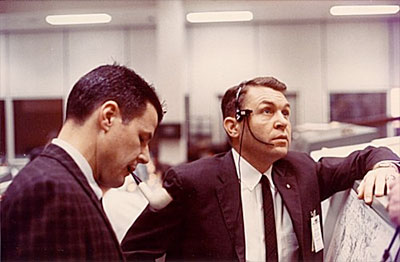 And here's Bassett suited-up (without the pipe)... 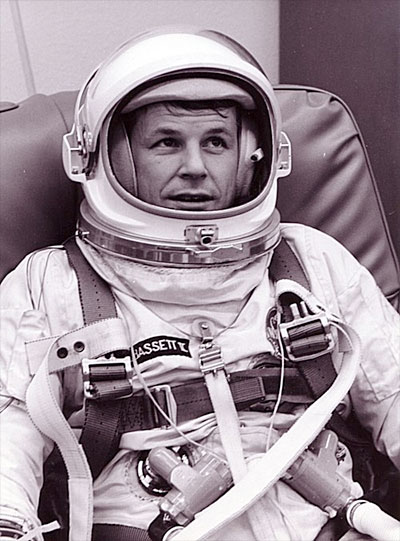 |
ejectr
Member Posts: 2037
From: Killingly, CT
Registered: Mar 2002
|
 posted 10-31-2007 06:38 AM
posted 10-31-2007 06:38 AM
   
That picture of Bassett in the spacesuit has an astronaut's astronaut written all over it to me. |
taneal1
Member Posts: 274
From: Orlando, FL
Registered: Feb 2004
|
 posted 11-02-2007 09:29 PM
posted 11-02-2007 09:29 PM
   
quote:
Originally posted by ColinBurgess:
Pilot error may have been a contributing factor in that terrible crash, but there was also a lot of ground control confusion amid some particularly filthy weather.
As always, well said. Additionally, Stafford's and Cernan's recounting of this accident differ in many respects from their statements in the official FAA Accident Report. Certainly they may be relating the details as they recall them. Not that I blame them, but there is a bit of CYA in their accounts.Something of great significance that is never mentioned: shortly after this accident "circling approaches" were no longer allowed. They had been considered dangerous for many years but were still legal approaches. In this type of approach the aircraft makes an approach to the landing runway, but overflies it followed by a left or right turn to set up a visual pattern to land. This circle is performed at an altitude as low as 400 feet above the ground. An extremely short-radius turn is required to keep the runway in sight. Weather (i.e. ceiling and visibility) are not necessarily reported at the touchdown end of the runway for this type of approach. Visibility can vary significantly during the circling maneuver during rain showers. According to the accident report heavy rain showers obscured the touchdown end of the runway AND the McDonnell building with visibility FAR lower than legally required to safely execute a circling approach. Also, as Colin mentions the weather was much worse than was reported to the astronauts. They were perfectly justified in executing this type of approach. See and Bassett most likely lost sight of the runway as they were in the process of completing the final turn to align with the runway. When they lost visual contact with the runway, See executed a Missed Approach. This is exactly what you are supposed to do. The accident report stated that they did nothing contrary to FAA regulations and procedure. They were at a low altitude and in a turn when they lost sight of the runway. At this point how do you complete the turn and be certain that you are exactly aligned with the runway? At the same time you are raising the nose and adding power to execute a go-around. If you are aligned with the runway and the aircraft tracks the center of the runway (remember, you cannot actually see the runway, and your instruments cannot tell you where the runway is...) then you are guaranteed to have altitude clearance above any terrain, buildings, etc. Unsurprisingly, See and Bassett were slightly to the side of the runway, but they had no way of knowing this. The McDonnell building is quite tall and is very close to the runway. In 1966, McDonnell would not have been allowed to construct such a tall building that close to the runway. But, the building had been there for years so it was allowed. Assuming See was actually considered an old lady pilot before this accident, I have wondered for years whether he was aware of this opinion. If so, could he have been trying to show his peers that he wasn't a sub par pilot by continuing this approach? According to Frank Borman, he himself took a lot of abuse from his fellow astronauts for taking the longer over land route from Houston to the Cape, rather than overflying the Gulf. Borman's reasoning was simply that it was safer. Why risk the airplane and crew when it wasn't necessary? Obviously, the commander of the first flight to the moon was no "old lady," yet he only flew "like a fighter pilot" when he was a fighter pilot. By the way, Borman states that he held Elliot See in high regard as a pilot and astronaut. Even according to Borman, Borman is not one to pull any punches, so this is most likely his actual opinion. Perhaps Borman, unlike others, was judging See's piloting "style" not as a fighter pilot, but as the pilot and astronaut that he currently was... quote:
Let us not forget that he was selected in the second NASA astronaut group.
Slayton could have chosen guys like Dick Gordon or Mike Collins (who were turned down for Group 2), but he chose See. He has stated that he was under no pressure to chose civilians. All in all, I think See (and his family) deserve better treatment. Many if not all of the astronauts made errors in their careers. Some of which could have been fatal. But See never got the opportunity to redeem himself during a spaceflight. |
KC Stoever
Member Posts: 1023
From: Denver, CO USA
Registered: Oct 2002
|
 posted 11-02-2007 09:43 PM
posted 11-02-2007 09:43 PM
   
I have wonderful images (Kodachrome slides) of Candy Carpenter at her birthday in Timber Cove with best friend Sally See, from two blocks away.What Tom writes makes sense to me. |
ColinBurgess
Member Posts: 2170
From: Sydney, Australia
Registered: Sep 2003
|
 posted 11-02-2007 10:31 PM
posted 11-02-2007 10:31 PM
   
Tom, you are a class act. That was an outstanding and well researched summation of the events that truly deserves to be far more widely read and understood. Thank you. |
Jay Chladek
Member Posts: 2272
From: Bellevue, NE, USA
Registered: Aug 2007
|
 posted 11-02-2007 10:54 PM
posted 11-02-2007 10:54 PM
   
Well, one thing a lot of people don't consider is that when "pilot error" is used, it has a stigma attached to it that seems to range from "less then perfect" to "a real pooch screwer." That is not the case at all. One of the first things I learned when I first took flying lessons was the classic saying that flying isn't inherently dangerous, but it can be very unforgiving. The trick is to have your mistake or curve ball at a point where one can recover from it.Neil Armstrong's own flight experience is a classic example with him surviving two ejections (one in a Panther jet in Korea, the other in the LLTV) and being able to also recover from ballooning an X-15 to an altitude where he was too high to make a turn back to Edwards. Two were out of his control, one was sort of in his control. But none makes him a bad pilot. Every pilot has a lot of little flubs they make in the cockpit. Any pilot (even Yeager) who says they can do it perfect everytime is lying through their teeth, no matter how much experience they have. It doesn't happen. See's bad luck just happened to come at the wrong time and resulted in his death and that of Bassett. Be it pilot error or not, it doesn't mean I think of him any less then another pilot as he apparently seemed to be trying to do things by the book on that approach. We ultimately don't know what happen. Now if a pilot (even an astronaut) was deliberately screwing around (such as Gordo's low flyby buzzing stunt before his Faith 7 flight, or say a VFR rated pilot with no IFR time who deliberately takes off in IFR conditions with passengers and learns the hard way), then that would be different as not following the rules can put people in harms way for no reason. If something does go wrong and the pilot owes up to it (assuming they survive), then that is different as it means they are taking responsibility for their actions. Take Gene Cernan's helicopter crash. He dipped a skid into the Banana River and sunk the copter when it got dragged under, but he owed up to his mistake when Deke kept asking "Gene, how high up were you when the engine quit?" (in nudge nudge wink wink fashion). He stuck to that story, knowing full well it might have cost him command of Apollo 17, because that is the kind of man he was. There is nothing wrong with "pilot error." Making mistakes is part of the human experience and we learn from them (if we survive them). I've learned some of my best lessons from my own pilot errors (one of which could have killed me). |
cfreeze79
Member Posts: 467
From: Herndon, VA, USA
Registered: Nov 2000
|
 posted 11-02-2007 11:01 PM
posted 11-02-2007 11:01 PM
   
Where can one access the accident report? |
Delta7
Member Posts: 1772
From: Bluffton IN USA
Registered: Oct 2007
|
 posted 11-03-2007 07:49 PM
posted 11-03-2007 07:49 PM
   
quote:
Originally posted by taneal1:
Something of great significance that is never mentioned: shortly after this accident "circling approaches" were no longer allowed.
I assume you're referring to circling approaches being banned by NASA Aircraft Ops. Whether or not this is true, I don't know, but circling approaches are very much an option and part of the FAA's requirement for pilot training and evaluation to this day.Pilots are required to maintain the minimum circling altitude (typically 400 ft. above airport elevation) until in a position to make a normal descent to the runway, and must execute a missed approach if they lose sight of the "airport environment" at any point during the circling maneuver. They are a procedure allowing for very little margin of error with regard to obstacle and terrain clearance, and one that the average pilot such as myself would prefer not to do, especially in marginal weather or at night. Many commercial airplane operators forbid circling approaches under certain conditions or at select airports due to the terrain. I've bailed out of one or two myself because of the "pucker factor" often involved. My dad, a graduate of the United States Merchant Marine Academy (same as See) met Tom Stafford during a presentation of a flag that had flown on Gemini 9A not too long after the mission. He recalls Stafford saying See was a "good man and colleague." We'll never know what might have been. |
taneal1
Member Posts: 274
From: Orlando, FL
Registered: Feb 2004
|
 posted 11-04-2007 02:57 PM
posted 11-04-2007 02:57 PM
   
quote:
Originally posted by Delta7:
...but circling approaches are very much an option and part of the FAA's requirement for pilot training and evaluation to this day.
You are absolutely correct. I should have provided more info.For commercial operations under FAR 121 and 135, circling approaches are no longer allowed in less than VFR condition, i.e. 1,000 foot ceiling and three miles visibility. Even for non-commercial aircraft, the minimum visibility requirement to circle is increased based upon the minimum approach speed of the aircraft. The higher the approach speed of the aircraft, the wider the turning radius. Greater visibility is required to keep the runway in sight. The high-speed T-38 would be in the minimum 3 mile visibility category under commercial or non-commercial operations. |
Michael Cassutt
Member Posts: 376
From: Studio City CA USA
Registered: Mar 2005
|
 posted 11-04-2007 05:47 PM
posted 11-04-2007 05:47 PM
   
quote:
Originally posted by ColinBurgess:
...most of whom don't even know how to spell his first name correctly
The misspelling of See's name — cited here — is my error (abetted by a copy editor), not Slayton's. |
robsouth
Member Posts: 769
From: West Midlands, UK
Registered: Jun 2005
|
 posted 11-06-2007 06:06 AM
posted 11-06-2007 06:06 AM
  
quote:
Originally posted by ejectr:
That picture of Bassett in the space suit has an astronaut's astronaut written all over it to me.
So true, who knows what he could have achieved if he had lived. |
Delta7
Member Posts: 1772
From: Bluffton IN USA
Registered: Oct 2007
|
 posted 04-15-2008 12:21 PM
posted 04-15-2008 12:21 PM
   
Does anyone know if there's any kind of plaque or other marker at the site where Elliott See and Charlie Bassett perished?I fly into Saint Louis Lambert Field on occasion, and the FBO (General Aviation Terminal) where I go isn't very far from where it happened. I've tried to visualize what it would have looked like to see the T-38 breaking off and circling at low altitude from that vantage point, which would have been a pretty good one. I ask because I'd like to pay my respects if such a spot exists, but am wary about poking around, preferring to go by myself without any fuss if such is possible. Anyone know anything? |
ColinBurgess
Member Posts: 2170
From: Sydney, Australia
Registered: Sep 2003
|
 posted 04-15-2008 04:57 PM
posted 04-15-2008 04:57 PM
   
Although it may not be of much help to you, I was in close contact with both the Bassett and See families while researching "Fallen Astronauts" and none of them mentioned any sort of plaque or memorial at the site of the crash. In fact Jeannie Bassett said she could never bring herself to going anywhere near the place. |
micropooz
Member Posts: 1838
From: Washington, DC, USA
Registered: Apr 2003
|
 posted 04-15-2008 10:39 PM
posted 04-15-2008 10:39 PM
   
I worked at McDonnell Douglas in the early '80s. In Building 101, where their T-38 hit the roof, you could look up and see a different color area in the roof where it was repaired. But no plaque or memorial. After 25 years, the repair may not even be noticeable any more. |
Robert Pearlman
Editor Posts: 54282
From: Houston, TX
Registered: Nov 1999
|
 posted 02-28-2016 03:06 PM
posted 02-28-2016 03:06 PM
   
NASA release Remembering NASA Astronauts Elliot See and Charles BassettFifty years ago, the Gemini program was teaching NASA what it needed to know to be able to send crews to the moon. Astronauts were learning to walk and work in zero gravity. Pilots were practicing rendezvous maneuvers and docking spacecraft. Many of the Gemini crews included astronauts who would reach lunar orbit or walk on the lunar surface: Armstrong, Aldrin, Stafford, Young and Cernan, to name just a few. Two astronauts who were part of Gemini, and who might well have gone on to the Moon, never got the chance. Elliot See and Charles Bassett II, who were scheduled to fly Gemini IX in 1966, died when their T-38 training jet crashed at St. Louis's Lambert Field. They were the second and third casualties (after Theodore C. Freeman) of NASA's astronaut program. To say they've been forgotten would be an overstatement. But they haven't been as well-remembered as other astronauts, and on the 50th anniversary of their deaths, their stories are worth recalling. See, a 38-year-old Texan, had been a flight engineer and test pilot for the General Electric Company. He joined NASA in September 1962, part of NASA's second astronaut class (the "Next Nine", following the "Original Seven"). He worked with the teams developing guidance and navigations systems and was named backup pilot for Gemini V, then command pilot for Gemini IX. Bassett, 34, joined the third astronaut class after being a U.S. Air Force pilot. On the ground, he worked with the teams conducting astronaut training and simulations; Gemini IX would be his first assignment. On Feb. 28, 1966, See and Bassett left Ellington Field in a T-38 training jet for St. Louis. They were planning to spend several days working in the rendezvous simulator at the McDonnell-Douglas facility where their Gemini capsule had only recently been completed. They were accompanied, in another T-38, by their backup crew, Thomas Stafford and Eugene Cernan. The weather in St. Louis was poor for flying: overcast and raining with low clouds and limited visibility. From the NASA historical publication, On the Shoulders of Titans: "As the aircraft descended through the overcast, the pilots found themselves too far down the runway to land. See elected to keep the field in sight and he circled to the left underneath the cloud cover. Stafford followed a missed approach procedure and climbed straight ahead into the soup to 600 meters, intending to make another instrument approach. He landed safely on his next attempt. Meanwhile, See had continued his left turn. The aircraft angled toward McDonnell Building 101, where technicians were working on the very spacecraft See and Bassett were scheduled to fly. Apparently recognizing that his sink rate was too high, See cut in his afterburners and attempted a sharp right turn; but it was too late. The aircraft struck the roof of the building and crashed into a courtyard. Both pilots were killed." An investigative board chaired by astronaut Alan B. Shepherd attributed the crash to weather and pilot error on See's part in choosing to keep his plane so low. See and Bassett are buried near each other in Arlington National Cemetery. For the first time, NASA replaced a mission's primary crew with a backup crew. Stafford and Cernan completed the Gemini IX mission, which became the first flight on which crews attempted and succeeded on three rendezvous attempts. They would later fly together on Apollo 10, testing the lunar module around the moon in advance of Apollo 11. |
Tom
Member Posts: 1768
From: New York
Registered: Nov 2000
|
 posted 03-23-2025 03:26 PM
posted 03-23-2025 03:26 PM
   
I located this map on Wikipedia of Lambert Field in St. Louis.Reports indicate that See and Bassett were flying in a southeast direction to land on Runway 12 Right. After missing that initial attempt, See turned to the left to land on Runway 24. They missed the runway, flying too far to the north striking the McDonnell building housing both the Gemini 9 and 10 spacecraft. 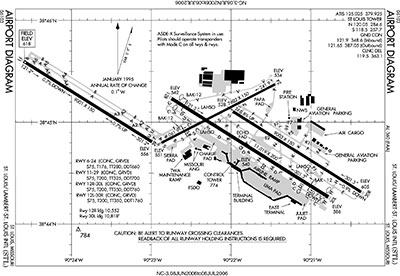 |
